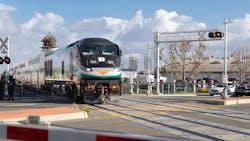Metrolink brings new wireless, smart crossing technology to two more rail crossings
Metrolink’s wireless crossing nearside station stop (WCNSS) technology is expanding to Riverside and Moorpark, Calif., to help ease traffic congestion for pedestrians and drivers around the agency’s stations.
The smart systems went live at the Columbia Avenue crossing just north of the Riverside-Hunter Park/UCR Station and at Moorpark Avenue west of the Moorpark Station in June.
Before WCNSS was installed, Metrolink says these crossings would activate more than once for a single train stopping at the nearby station, causing unnecessary interruptions. The recent changes, funded by a Consolidated Rail Infrastructure and Safety Improvements program grant awarded by the Federal Railroad Administration in 2018, are minimizing delays and improving safety in these high-traffic areas.
“A robust public transportation system is critical to Riverside’s continued growth,” said Rep. Mark Takano (CA-D-39). “Metrolink’s new project will make their services more efficient and relieve traffic congestion near the Hunter Park/UCR Station. Bringing federal dollars back to Riverside has been a priority for my office, and I am pleased to see the completion of this project.”
Previously, as Metrolink trains approached these stations, they would trigger the downstream crossing’s safety features, which reset while trains were stopped to allow passengers to board and exit. When the trains resumed their routes, the crossing gates would lower again, bringing traffic to a halt a second time. Metrolink says WCNSS-equipped crossings prevent this by communicating in real time with its onboard Positive Train Control system to ensure safety features remain idle until the train is ready to move through. This keeps traffic flowing without compromising the safety of rail passengers and crews or the surrounding community.
Since 2018, Metrolink notes it has worked in partnership with the city of Moorpark and the Ventura County Transportation Commission to address the unnecessary rail crossing activations along the heavily used Moorpark Avenue corridor. A Moorpark City Council meeting that year reinforced the need for a coordinated response, paving the way for the long-term fix now in effect.
Metrolink first introduced WCNSS capability in October 2022 at seven crossings along the Arrow service, connecting San Bernardino and Redlands. Last June, Metrolink upgraded the Del Obispo Street crossing in San Juan Capistrano in Orange County, sparing the community an estimated 1,584 activations and 36 hours of delays in the past year. WCNSS technology also went live in February at the Juniper Avenue crossing in Fontana in San Bernardino County. The Columbia Avenue crossing in Riverside County and Moorpark Avenue crossing in Ventura County are the most recent installations, and work is underway in Los Angeles County at the Ramona Avenue crossing near the Baldwin Park Station on Metrolink’s San Bernardino Line.
A total of 52 locations across Metrolink’s six-county network are eligible for WCNSS treatment. The agency says it’s actively seeking funding to expand the technology to all remaining sites.
